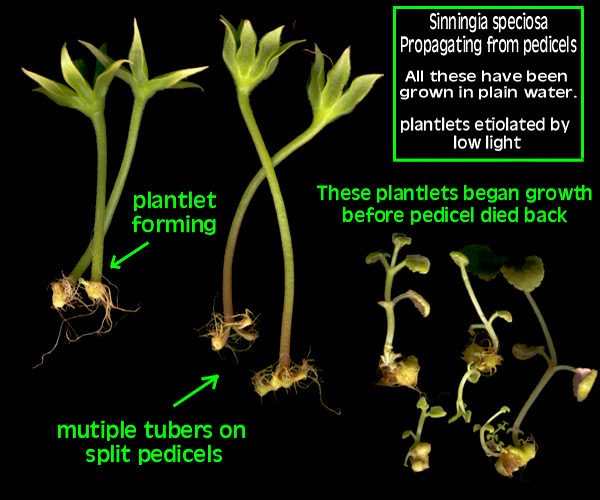Pedicel propagation of Sinningia speciosa:

These are various flowers of florist gloxinias, rooted only in water.
They are both compact and larger varieties, and it was also successful with a wild-type plant. A few cultivars were pollinated while still on the plant, and have continued to develop and ripen seed while forming a tuber. The Wild-type was the fastest to ripen seed this way.
The easiest method I have used is to simply remove the whole flower and stalk from the plant when the flower begins to fade, remove the corolla, make a clean cut with a razor, and plunk the pedicel in a small container of water. A large shot glass holding about 2 oz. of water has been my favorite, anything would work. I believe the important part is keeping the cut end within a short distance of the surface, not so deep that the dissolved oxygen content around the growing cells is too low.
for the multiple tuber formation, I used the razor to slice the cut end of the pedicel radially, using either two cuts for four segments, or three cuts for six. I cut into the tissue about 1/2" (+/- 1 cm). These are just put in water the same as the others.
When callus tissue forms along with a few roots, you will get better formed tubers by potting the starts into small containers, of flats for a large number of them. I have only planted deep enough to hold the cutting upright- too deep planting seems to result in delayed shoot formation from the new tubers. The fastest way to get new growth is to simply leave the cuttings in water until either shoots form, or the original pedical begins to die back. The newly formed tubers directly from the water are far more sensitive to drying out than soil-formed tubers are- if you need to store them for any length of time, do so in moist peat or vermiculite.
After growth begins and plantlets are potted up, they are treated just like any other young plant. I only cover the plantlets for extra humidity if they have already grown leaves completely underwater. Sometimes those leaves will wither anyway, but new growth will resume either from the tuber, or from the section of stem that is buried or near the soil mix surface, and has not completely dried out.
Scans by Vincent Parsons, 2001
